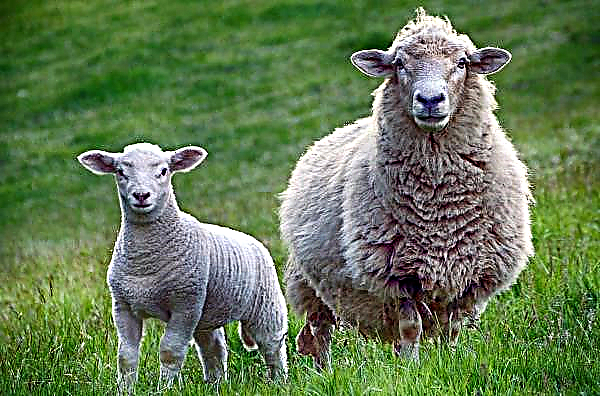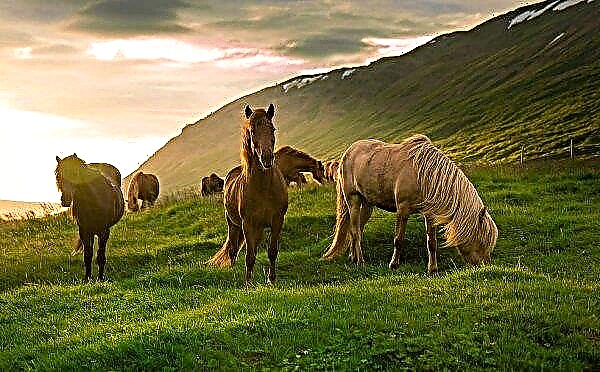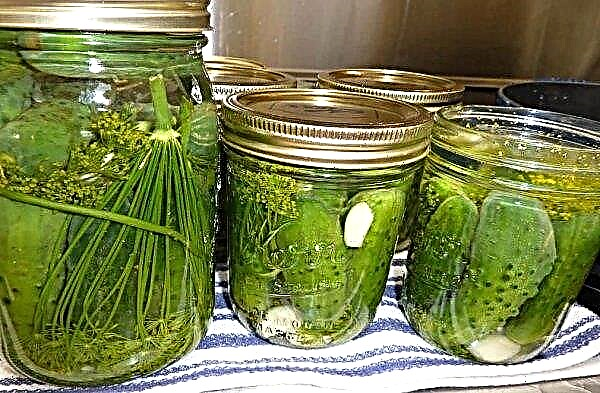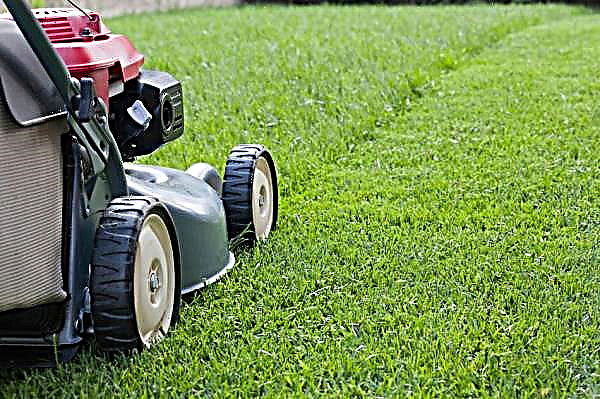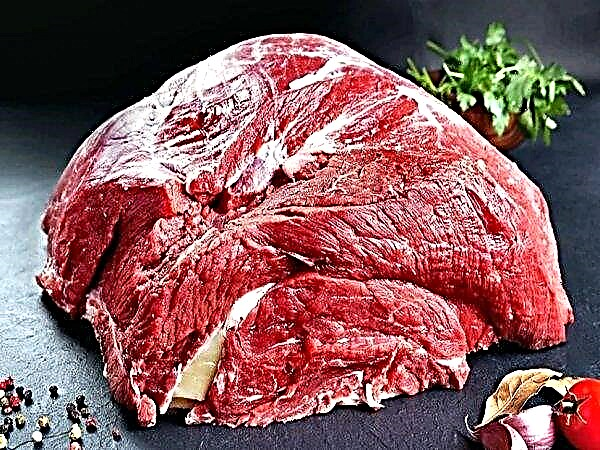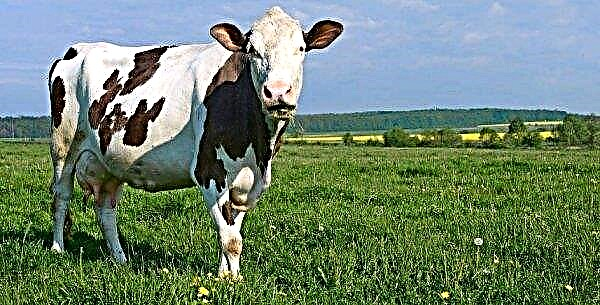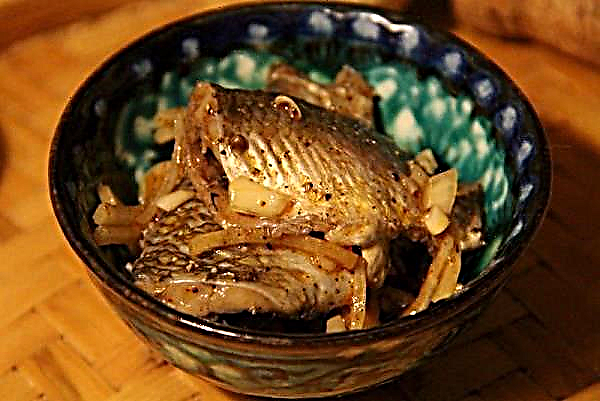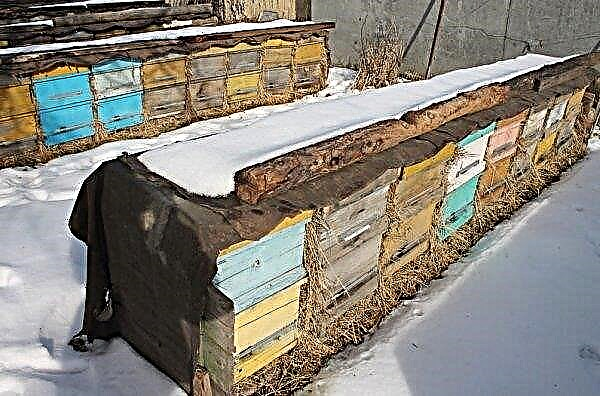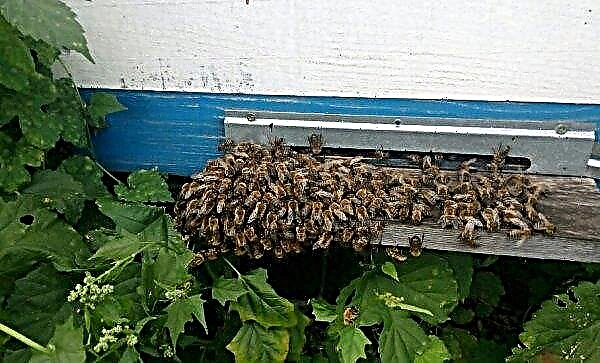When keeping a cow, it is important to monitor the state of its breast. Udder diseases are potentially dangerous and require a quick diagnosis, otherwise irreversible processes are possible.
List of ailments
This group includes diseases of the mammary gland of a cow and its components: nipples, duct, canals, milk tanks. Before treating the disease, you should contact your veterinarian and accurately establish a diagnosis of the symptoms.
Smallpox
Smallpox is a highly contagious disease of an infectious nature, characterized by fever and the spread of a rash.
| Causes: | Symptoms |
| weakened immunity; | rashes in the form of bubbles with a yellowish filling; |
| damage to the skin or mucous membrane through which the virus penetrates. | spots on the udder with redness; |
| rashes leave scars or ulcers. |
Treatment
The veterinarian determines the treatment, which includes taking antibiotics, treatment with antiseptics and healing agents.
Did you know? In the 18th century, during the smallpox epidemic, milkmaids were invulnerable, which is why scientist Edward Jenner revealed the similarity between cow and human smallpox. In 1796 he vaccinated his worker’s son with the vaccinia virus, after which he gained immunity from the disease - thus vaccination was created and scientifically substantiated.
After a course of therapy with positive results, the animal acquires immunity to smallpox.
Mastitis (inflammation)
Mastitis is an inflammation of the mammary gland.
| Causes: | Symptoms |
| bruises; | fever; |
| hygiene violation; | compaction of the gland; |
| side effect of endometritis; | redness; |
| feeding excessive amounts of concentrates; | impurities in milk; |
| taking poor-quality medicines. | stopping milk production. |
Treatment
With mastitis, antibiotics are used (as prescribed by the veterinarian), they resort to a massage course and gradual milk donation.
The room in which the cow is staying should be cleaned and conditions of feeding and feeding should be changed.
Edema after calving
Many farmers face the problem of swelling of the udder in cows, and most often this phenomenon is observed precisely after the appearance of the calf. Normally, swelling goes away a few days after calving, but in some cases, swelling can lead to more serious problems in the form of mastitis and decreased milk yield.
Causes. Sometimes swelling is associated with severe first birth of a cow or the presence of problems with her heart and kidneys.
| Causes: | Symptoms |
| restriction of the mobility of the animal during pregnancy (especially in the last few months before childbirth); | increase in the entire udder or its individual part; |
| toxicosis; | shortening of individual nipples; |
| malnutrition (especially if before the birth of the calf the cow was fed a large amount of juicy and acidic foods); | thickening of the skin (when you click on the skin, small recesses remain); |
| possible injuries and bruises of the udder. | pale color of the udder, which to the touch may turn out to be cold and perfectly smooth; |
| watery milk. |
 Treatment
Treatment
A treatment regimen for udder edema is developed taking into account the complexity of the case and may include not only drug effects, but also changes in the cow’s living conditions.
The most common ways to combat the disease include:
- the exclusion of succulent feed from the diet of the cow and a decrease in the amount of drinking;
- grazing separately from the herd for at least 3 hours a day (you can divide this time into several walks);
- frequent expressing of milk with severe puffiness (up to 6-8 times a day);
- regular massage of the udder in the direction from the lower part of the mammary gland to its base;
- the use of a special bandage with a very sagging udder;
- intravenous administration of calcium-containing drugs;
- drinking or feeding laxatives and sea buckthorn oil;
- the use of decongestant ointments that prevent the development of inflammation (for example, “Rigefen”).
In some situations, herbal decoctions from the fruits of juniper, birch buds and horsetail will be useful, but in any case, the treatment strategy should be discussed with the veterinarian.
Dermatitis
Udder dermatitis is a skin lesion characterized by the development of an inflammatory process.
| Causes: | Symptoms |
| hypothermia; | the skin becomes red; |
| weathering; | lymph nodes increase; |
| improper diet with subsequent metabolic disturbance; | with a purulent type, the skin thickens and becomes covered with suppurating cracks; |
| violation of sanitary standards. | when milking, the cow feels pain if dermatitis develops on the nipples; |
| the appearance of white blood cells in milk is possible. |
Treatment
If the reason is a violation of the content or feeding standards, the conditions and type of feeding should be changed. The udder should be washed with a solution of soda or soapy water and treated with a mild disinfectant (for example, ichthyol, zinc ointment or boron paraffin).
In purulent processes, the organ is washed with a solution of potassium permanganate or hydrogen peroxide, after which ointments are used. When wet, the foci should be treated with powder (mixed in equal proportions with talc, xeroform, zinc oxide and tannin). During treatment and for further prevention, special attention is paid to hygiene.
Furunculosis
Udder furunculosis is an inflammation of the sebaceous glands and hair bags with the concomitant development of a purulent process. The causative agents of the disease are streptococci and staphylococci.
| Causes: | Symptoms |
| non-compliance with hygiene standards; | udder red with yellow tint; |
| metabolic disorder; | thinning of the skin; |
| impaired functioning of the glands. | the appearance of large festering boils; |
| the formation of inflamed foci. |
Treatment
The udder is washed and treated with iodine. When purulent sores mature, they should be opened and treated with an antibiotic.
Warts (papillomas on the udder)
Warts (papillomas) on the udder are small papillary tumors of viral origin.
| Causes: | Symptoms |
| cracks in the skin; | the appearance of small neoplasms; |
| untreated wounds on time; | their gradual growth. |
| immune disorders. |
Treatment
The skin should be treated with preparations containing salicylic, lactic or acetic acid. Celandine extract is also used. In some cases, novocaine injections and a course of cobalamin are used for therapy.
Udder induction
Induction of the udder is an irreversible densification of tissues.
| Causes: | Symptoms |
| prolonged swelling with stagnation; | lack of pain in the animal; |
| transferred inflammatory process. | seals in the gland; |
| the appearance of mucous flaky impurities in milk; | |
| gradual development of the disease. |
Treatment
Therapy does not make sense, the process is irreversible.
Abscess
Udder abscesses - inflammation of the tissues with the formation of a purulent cavity.
| Causes: | Symptoms |
| getting the bacterial pathogen into the ducts; | swelling of tissues; |
| injuries, cracks, bruises of the mammary gland; | the formation of a purulent cavity; |
| hygiene violation. | the appearance of tuberous foci; |
| soreness; | |
| heat; | |
| enlarged lymph nodes; | |
| general malaise. |
Treatment
If the inflammation is dispersed, the skin is treated with ichthyol ointment. Large abscesses are opened vertically, cleaned of pus and treated with iodine, ichthyol solution. Antibiotic treatment is indicated. Massage is strictly prohibited.
Foot and mouth disease
Foot and mouth disease is an acute infectious viral disease in cattle, which is characterized by high contagiousness and the possibility of transmission to humans.
| Causes: | Symptoms |
| contact with infected animals, including during joint feeding, watering, grazing; | fever; |
| feeding by waste after consumption by an infected animal; | profuse salivation; |
| the spread of viral particles by airborne droplets; | aphthae and erosion on the udder and mucous membranes; |
| contact with infected objects. | milk with mucus and a bitter aftertaste; |
| decreased milk production productivity; | |
| indigestion, diarrhea; | |
| damage to the limbs. |
Treatment
Symptomatic therapy is used.
Strict monitoring of feeding and sanitary standards is required:
- frequent airing;
- passing a disinfection sawdust barrier with tar;
- the use of formalin baths (5% solution);
- litter change;
- compliance with rest during therapy;
- drinking the animal with clean water to avoid dehydration.
Did you know? Cattle foot and mouth disease was first identified and described by D. Fracastoro in Italy in 1546.
An infected cow is daily treated with lesions of the oral cavity with furacilin (0.5% solution) or potassium permanganate (0.1% solution). The limbs and hooves are daily cleaned and treated with a mixture of tar and fish oil.
The udder is treated with a synthomycin emulsion, propolis vaseline ointment (15%) or a mixture of tripoflavin, petroleum jelly and novocaine in a ratio of 1: 100: 4. The disease lasts 10-15 days. The entire livestock after recovery of the last infected cow is quarantined for 21 days.
Cracked nipple skin
Cracks in the nipples are a pathological condition that develops as a result of a decrease in the elasticity of the skin.
| Causes: | Symptoms |
| rough milking with tweezers; | cracks and furrows with redness; |
| the udder is not lubricated; | soreness during milking. |
| the skin of the nipples is permanently wet; | |
| dirty conditions. |
Treatment
Prepare a soda solution (1–2%) and clean the cracks. Further, until complete recovery, they are lubricated with ointment (zinc, streptocidal or ichthyol).
Injury
Bruise - damage to the tissues of the udder due to a trauma.
| Causes: | Symptoms |
| strike with a udder on a solid object; | hematomas; |
| the fall. | bumps; |
| bloody impurities in milk; | |
| soreness during milking. |
Treatment
The pain is relieved with novocaine and gentle milking. Ice is applied to the hematoma and treated with a solution of iodine (5%). The animal must be in a relaxed atmosphere.
Important! Timely untreated bruises can lead to the development of mastitis.
Milk stones in the udder
Dairy stones - the formation in the mammary gland of deposits in the form of phosphoric salts or calcifications of casein flakes.
| Causes: | Symptoms |
| defective milking; | hardness; |
| inflammation of the walls of the duct; | sand is found in milk; |
| general metabolic disorder. | dense formations in the nipple. |
Treatment
Small stones should be pulled out of the nipples with a slight extrusion. Formations that do not exit through the ducts are pre-crushed with a catheter, the introduction of potash (1% solution) or by massage. Large-sized stones are removed by an operational method.
Openings are sutured, a catheter is inserted into the nipples until complete recovery.
Milk retention
Milk retention is the condition of a cow in which milk does not come out of a dairy tank with a normal nipple canal.
| Causes: | Symptoms |
| stress due to a change of scenery; | the udder is full, but the milk tank is empty; |
| rough milking; | sharp reduction in milk yield; |
| cruel treatment; | the mammary gland is not affected. |
| Fright | |
| nervous excitability. |
Treatment
With the exclusion of hypogalactia, agalactia, the absence and narrowing of the nipple canal and self-extrusion, the milking process should be established. The cow is placed in calm conditions, an udder massage is performed.
Milk incontinence
Milk incontinence (lactorrhea) - involuntary leakage of milk from the udder without human intervention.
| Causes: | Symptoms |
| weakness of the milk channel; | drops of milk stand out from the nipple; |
| duct expansion; | milk flows in streams. |
| nipple injuries; | |
| scars in the ducts; | |
| paralysis, atrophy, or sphincter weakness; | |
| swelling in the nipple; | |
| stress; | |
| critical violation of the temperature regime. |
Treatment
To begin with, the etiology of the disease is determined:
- for violations of sphincter tone, iodine ointment is used (1-2%) and massage is used;
- with paralysis of the sphincter or expansion of the ducts, the canal is narrowed by ligation for 10 days;
- with post-traumatic scarring or the occurrence of tumors, surgical intervention is necessary;
- To retain milk, use a collodion cap or squeeze the nipples with a rubber ring.
Narrowing of the nipple canal (stiffness)
Hardness is a condition of the mammary gland characterized by narrowing of the nipple canal. With this disease, milk is obtained only with the use of force and in small quantities.
| Causes: | Symptoms |
| a consequence of improper intrauterine development; | milk comes out of the nipple with the use of force in a small stream; |
| sphincter contraction; | when palpating, seals (scars) are detected; |
| hypertrophy of the nipple; | the catheter does not pass through the milk duct and gets stuck at the site of narrowing. |
| scarring after the inflammatory process; | |
| injuries during careless milking. |
Treatment
When narrowing, hot baths, treatment with antiseptic and anti-inflammatory ointments (ichthyol and camphor) and further wrapping are recommended. Milk is removed through a catheter. At a stage close to infection, they resort to operational expansion.
Congenital absence of the nipple canal
Congenital absence of the nipple canal - a pathological condition in which there is no hole in the udder or the nipple canal itself.
| Cause: | Symptoms |
| developmental abnormalities. | the udder without the nipple canal is full of milk; |
| there is no hole on the nipple; | |
| it is impossible to milk milk from the abnormal quarter; | |
| sphincter of the nipple is absent. |
Treatment
Surgical intervention required. For artificial duct formation, a trocar is used. Most often, such an operation has side effects in the form of fistula formation or leakage of milk, in connection with which either the upper part of the nipple is cut out or the fistula is implanted.
Prevention of udder diseases
One of the main factors in the proper maintenance of cows is the prevention of pathologies.
To prevent udder diseases:
- observe hygiene in the barn;
- provide feeding and watering in accordance with the standards;
- wash hands thoroughly before milking;
- comply with the technology of hardware milking cows;
- identify symptoms of diseases on time;
- do not allow injuries;
- use caution when using a catheter;
- timely notice and treat bruises, bruises, burns, wounds;
- isolate cows with signs of disease;
- conduct timely vaccination.
 Diseases of the udder of cows can be both easily treatable and require complex therapy.
Diseases of the udder of cows can be both easily treatable and require complex therapy.Important! Do not neglect the routine analyzes and examinations of the veterinarian.
Timely detection of the disease will help keep the cow lactating and save other cattle from the livestock.

